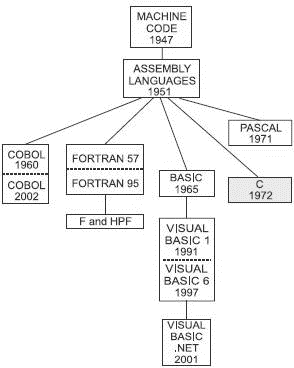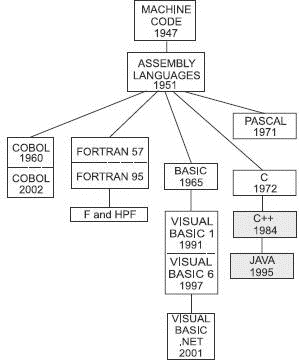Книга: Introduction to Microprocessors and Microcontrollers
C
C
Apart from teaching good programming habits, Pascal was largely replaced by the language called C, invented a year after Pascal and allowing all the good practice programming methods of Pascal with a few extras (see Figure 10.9).

Figure 10.9 C
The main difference is that it is a lower-level language than Pascal which may seem a strange improvement. Its advantage is that it can control low-level features like memory loading that we last met in assembly without all the drawbacks of using assembly language. It has many high-level features, and low-level facilities when we require them and can produce very compact, and therefore fast, code.
C++ and object-oriented programming
A new version of C has included all of the previous C language and added a new feature called object-oriented programming. This version, called C++, is referred to as a superset of C (see Figure 10.10).

Figure 10.10 C plus objects and Java
Object-oriented programming is a somewhat different approach to programming. In all previous cases, a task has been set and we look at the problem in terms of what processing is required to reach the required result. In object-oriented languages we have a number of objects which can be anything from some data, a diagram on a monitor screen, a block of text or a complete program. Once we have defined our objects, we can then allocate them to their own storage areas and define ways of acting on the entire object at the same time.
As an example, if we drew a square on the monitor screen and wished to move it, we could approach this in two ways. We could take each point on the screen and shift its position and hence rebuild the square in a different position. The object-oriented approach would be to define the shape as an object, then instruct the object to move. This is rather similar to our way of handling parts of the screen in a Windows environment. We use a mouse to take hold of an object, say a menu, and simply drag it to a new position. The menu is being treated as a single lump, which is an example of an object.
All the menus have similarities and differences. Similar objects are grouped into ‘classes’. A class includes the definition and type of the data together with the methods of manipulation that can be applied to an object. In our example of a class including the menus, each specific menu is called an ‘instance’. All of a class share some properties called ‘public’ properties and are different in some way, like different text being entered, these are called ‘private’ properties. As we saw earlier, C++ is just standard C with the object-oriented extras added to it.
- Глава 2 Табличный редактор Microsoft Excel
- Клонирование по сетке ("Copy to Grid")
- 12.7. Класс CheckboxGroup
- 6.3.2. Процедура сбора качественных данных
- «Плиточные» структуры и квазикристаллы
- 16.13 Формат сообщений MIME
- Как уразуметь свою техническую роль и придерживаться ее
- Отправка запроса
- Build a Run-Time Image for an OS Design
- Как отвечать на письма, полученные вашей организацией
- 5.1.1. Создание трехмерной модели радиатора
- Привязка к процессорам




